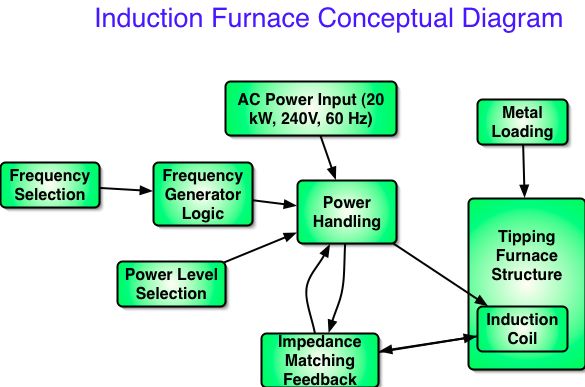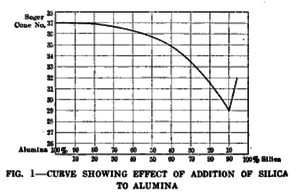Induction Furnace Overview
Main > Digital Fabrication > RepLab Tools > Induction furnace
Overview
Introduction
The Open Source Induction Furnace Project seems to be the most promising way to implement the foundry. This project involves the design of:
- a high-power induction furnace circuit (between 20 and 50 kW), and
- the melting chamber proper
test
Well, we could buy a turnkey system perhaps for $5k total used, and run it from the LifeTrac generator. The only disadvantage to this route is that if it breaks we’re dead-in-the-water – either with the impossibility of fixing closed-source technology, or a high repair bill. A single component which blows and is inaccessible for fixing could in principle turn a working power supply into worthless junk. Thus, it is worthwhile to tame this technology by open-sourcing the design.
Goals
To fulfill our foundry goals, The furnace should have the following characteristics:
- Induction furnace or any other technology that can do this within a budget of 40 kW of electric input, with minimal pollution
- Suitable for melting all metals and alloying
- 150 lb per hour steel melting furnace for casting
- 240 v ac, 40 kW power source available
(This spec implies ~260watt-hr/lb, which may be optimistic -- see Melt calculations)
Conceptual Diagram
This is a conceptual diagram of the entire Induction Furnace system from the Global Village Construction Set. The furnace is powered by 20 kW of 240VAC electricity from the LifeTrac generator. The entire system includes the power electronics, induction coil, and heating vessel - into which metal for melting is inserted. This diagram intends to document the relationship of functional components in the induction furnace system, as a basis for technical development of components and their integration.
The electronics part should be adaptable to different metals and different metal melting coil geometries. Melting coils should also be modular, such that the power electronics can feed different coils. Basic functions include selection of heating frequencies, which are required for melting different metals or metal geometries. There should be a feedback in the electronics, where the amount of power given to the coil should match the quantity/geometry of metal being melted.
Details
The complete design should include all of the following:
Induction Furnace Circuit
- Scalable from 20 up to 50 kW (perhaps even more)in units of 1 or 5 kW
- Allows for power and frequency range selection for different materials and heating devices
- small crucibles ~50kW, ~1kHz
- heat treating small parts ~5kW, ~100kHz
- Incorporates self-tuning to track the coil resonance dynamically during operation
- Power source may be either 1 or 3 phase electrical power
See also Power Supply Notes below.
Heat Dissipation System
Specifications of a cooling or heat dissipation system.
Coil
- Modular, adaptable design specifications for primary coil windings
Water-cooled copper tubing coil.
In lower frequency furnaces, it seems a cylindrical iron or steel yoke surrounds the coil, forming part of the magnetic circuit and improving efficiency. This Turkish manufacturer [1] shows some coil construction details and the use of laminated transformer steel for the yoke.
Melt Chamber
- Geometical design of melt chamber and basic power transfer calculations
- Should include provisions for loading and pouring
- Given our goals, which is best: a coreless or a channel induction furnace type [2] ?
- channel: useful in the melting of lower melt temperature metals; less turbulence at the surface.
- coreless: stronger stirring
- Pouring: manual pouring methods are more suited to low volume production lines.
Crucible
- See: Crucibles for Induction Melting - Guidelines for Selection and Use: http://www.engineeredceramics.com/crucible.htm
- DIY small crucible video [3]
Fireclay for making refractory crucibles must withstand the superheated molten steel temperature of >3000F. Fireclay [4] is temperature-rated by Pyrometric Cone Equivalent (PCE) [5]; "High Duty" (>= PCE32) is needed. Such fireclay has high alumina content.
Some worthwhile DIY fireclay/firebrick information here
According to this Foseco refractories brochure[6], steel foundry applications typically use alumina or magnesia refractories, while cast-iron foundries use high purity silica. This is related to acid/base chemistry of the melt.
Other Considerations
- Complete bill of materials
- Fabrication files for circuit and other components
- Sourcing information for components
- System design and process flow drawings
Notes
Benny
I just read that you plan to build up an induction furnace. That´s a an interesting and exciting plan.While reading the article some remarks came to my mind.
But before I want to introduce myself:
I am Benny from Germany, Hannover. I am diploma engineer for electrotechnology and working at the university. I am dealing with some induction heating/ melting applications like induction melting of glasses (that is possible!) and induction furnaces for cast iron.
Some remarks from my point of view:
- It is possible to build up a low cost furnace with the mentioned parameters.
- The frequency of 9,6 kHz is much to high. The efficiancy will be so bad, that it will be hardly possible to melt steel or iron. Due to the small penetration depth of about 2 mm with this frequency and this electrical resistance. So it needs a really small diameter of the crucible, and thats not helpful. Also the refractory material will be strained too much, so that a small lifetime is given. This will raise the cost for the operating.
- 50 Hz or 60 Hz is a better solution. And you can save the cost for the hf-converter.
- How much material do you want to cast at one time? The maximum, what i expect to be possible with 50 kW will be about 50 to 60 kg.
- What kind of raw material should be charged? It is important for the starting, because the initial density should not be too small (packing density). And the other question is, what kind of scrap it will be.
There are so many problems known with content of zinc (hot zinc dipped) and other materials. The lifetime of common refractory material is really small. And what is more important the security for the personal is not given without a strong exhaust system, due to the toxic steam. I expect this as a strong cost factor.
Power Supply
There are two approaches to providing the single-phase high-frequency AC power required by the induction furnace coil
- Electronic converter (Universal Power Supply)
- Wide frequency tunability possible - including very high frequencies for heat treating small parts
- Dynamic auto-tuning to coil resonance using established phase detector control methods
- power source: DC from battery storage banks
- power source: AC from 50/60Hz power
- Typically the induction furnace power converter then operates AC->DC->AC
- Preferably 3 phase AC source at higher power levels (better efficiency)
- 50/60Hz AC can come from battery banks thru DC->AC converter, or from rotary generator driven by engine or hydraulic motor
- Rotary generator
- Limited frequency range
- up to several hundred Hz with conventional designs (e.g. automotive alternator style), perhaps adequate for crucible melting applications
- >100kHz historically feasible with Alexanderson reluctance generators
- frequency controlled by varying shaft speed: frequency = shaft speed * pole pairs
- dynamic auto-tuning to coil resonance may be difficult
- Mechanical power source
- electric motor (motor-generator set)
- prime mover (internal combustion or steam engine)
- hydraulic
- Power Cube
- Stationary hydraulic power
- shaft speed control by variable displacement motor or hydraulic transformer
- Limited frequency range
- 50 kW for $1600 - [7]
- 20 kw STC 3 phase 120 - 480V, also 1 phase - generator - $692 -[8]
- 50 kw STC 3 phase- $1300 - [9]
- LifeTrac 55 hp can produce 38 kW with this head
Melt Calculations
Note: Electrical input requirements may be reduced somewhat by preheating the charge with flame or direct solar energy.
Photo I took while visiting a foundry near Santa Fe. Seems relevant!




